FORTY-FIVES
There’s a story, perhaps apocryphal, that when the Commandant of the US Marine Corps was asked, “Why do the Marines carry .45’s?” the answer was, “Because nobody makes a .46.” Whether or not the story is true is irrelevant. The fundamental truth it embodies is this: “Bigger is better,” at least when it comes to handgun calibers.
 In fact someone does make a “.46” (the obscure .460 Rowland) but “a Forty-Five” is the standard against which all other handguns are measured, and rightly so. It’s more or less the largest caliber bullet that can be used in a gun of reasonable size by the average person, and its effectiveness has been proven countless times in the field, in combat, on the target range, and even in the backyard popping at old cans and bottles. Such monsters as the S&W’s Model 500 (at left) in .50 caliber, and the Desert Eagle in .50 Action Express, not to mention a few oddities and freak one-offs in calibers like .50 BMG exist, but by no means can any of them be regarded as in the “mainstream,” nor are they of “reasonable” size, something an ordinary person might carry on his person at all, let alone concealed. (The S&W Model 500, on the very large “X” size frame, is so large that some versions are equipped with sling swivels. That isn’t a “handgun” in my book: if you need a sling to carry it, it’s a rifle.) So when it comes to something you can carry comfortably and (especially if it’s to be concealed) a “Forty-five” is it.
In fact someone does make a “.46” (the obscure .460 Rowland) but “a Forty-Five” is the standard against which all other handguns are measured, and rightly so. It’s more or less the largest caliber bullet that can be used in a gun of reasonable size by the average person, and its effectiveness has been proven countless times in the field, in combat, on the target range, and even in the backyard popping at old cans and bottles. Such monsters as the S&W’s Model 500 (at left) in .50 caliber, and the Desert Eagle in .50 Action Express, not to mention a few oddities and freak one-offs in calibers like .50 BMG exist, but by no means can any of them be regarded as in the “mainstream,” nor are they of “reasonable” size, something an ordinary person might carry on his person at all, let alone concealed. (The S&W Model 500, on the very large “X” size frame, is so large that some versions are equipped with sling swivels. That isn’t a “handgun” in my book: if you need a sling to carry it, it’s a rifle.) So when it comes to something you can carry comfortably and (especially if it’s to be concealed) a “Forty-five” is it.
What’s a “.45” Anyway?
There are many “Forty-five” calibers, more than can possibly be dealt with in any detail here; but I’ll discuss those I know something about. What all of them share is the approximate diameter of the bullet, typically somewhere between 0.450” and 0.455” with a nominal norm of 0.452” to 0.454.” Actual levels of power (on paper) in these various .45’s depend on bullet weight and muzzle velocity; but within their design parameters all of them will do the job they were designed to so.
That job is self-defense. Virtually all .45 caliber handgun rounds were intended from the first to be used for this purpose: certainly all of the older ones were, though some were later developed for sporting purposes. (The immensely powerful .454 Casull is an example of the latter: it was intended specifically as a personal protection round against large Alaskan bears. It’s chambered only in big revolvers to be carried by fishermen and hunters in bear territory.)
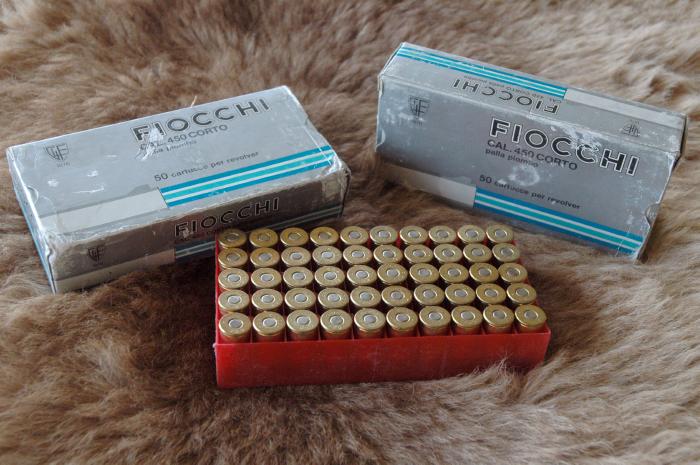 The Ancestral .450 Boxer
The Ancestral .450 Boxer
 I’ll begin with the .450 Boxer, which today is so obscure that most shooters have never heard of it. It's also known by some other names, and is sometimes called the ".450 Adams," but the "Boxer" designation was given by the British Army and it stuck. It’s still loaded by one company to serve those who own old guns chambered for it. More importantly it’s more or less the lineal ancestor of the much better-known .455 Webley. So it’s significant in more ways than one.
I’ll begin with the .450 Boxer, which today is so obscure that most shooters have never heard of it. It's also known by some other names, and is sometimes called the ".450 Adams," but the "Boxer" designation was given by the British Army and it stuck. It’s still loaded by one company to serve those who own old guns chambered for it. More importantly it’s more or less the lineal ancestor of the much better-known .455 Webley. So it’s significant in more ways than one.
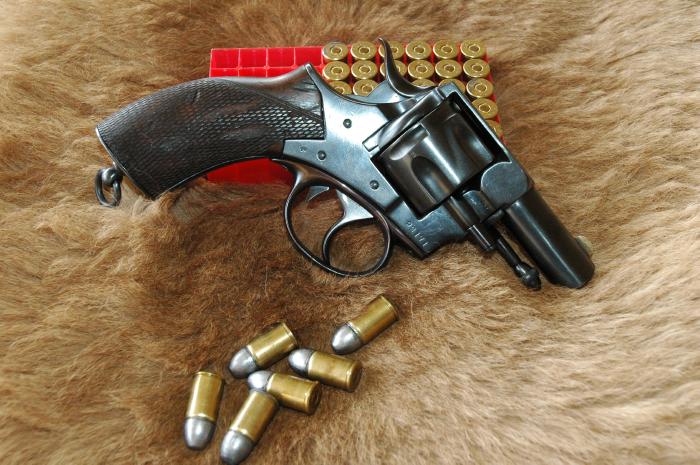
By today’s standards the .450 Boxer is not very powerful but it’s no slouch. A 225 grain bullet at 700 Feet Per Second (FPS) gives it a nominal muzzle energy of 245 Foot Pounds (FP), comparable to the standard .38 Special; but that big bullet hits hard and has enough mass to penetrate deeply. The Webley “Metropolitan Police” revolver chambered the .450 Boxer, and as the name of the gun implies, it saw service with police agencies. The New South Wales Police in Australia purchased and issued these guns. For their day they were suitable for such use and respectably powerful. The one shown here is one of the guns the NSW Police bought and is marked with the famous “Handcuffs” logo Webley stamped on guns marketed to police agencies.
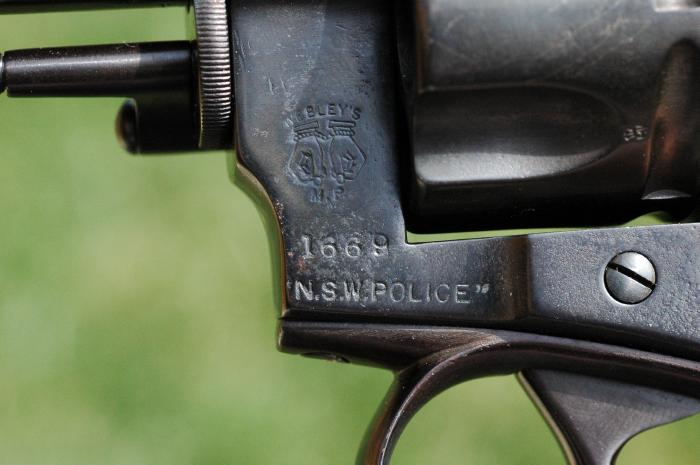
Probably the most famous “user” of the .450 Boxer was the fictitious detective Sherlock Holmes. He was good with it, too: in The Sign of Four (set in 1888) Holmes uses his MP to knock off the cannibal Tonga from a considerable distance; firing it from a racing boat on the Thames, no less!
The .450’s Most Famous Offspring: The .455 Webley
A number of variations on the theme of the .450 Boxer were made. It's major significance is that it was the “parent” of the .455 Webley, a cartridge that went through several “Marks” in its long service with the various military establishments within the British Empire.
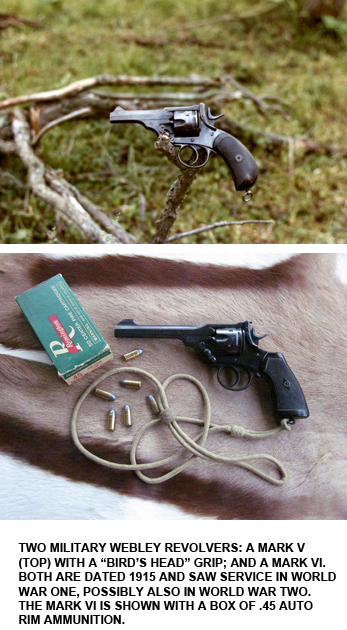 Undoubtedly the best-known guns that fired the .455 Webley are the big military top-breaks used by the British Army beginning in 1887 when the Mark I was adopted. Webley .455’s were used well into the 1950’s, when the UK began its post-WW 2 rearmament with the Browning Hi-Power. The Mark VI is the most iconic of the series of military Webleys, but earlier Marks had been used in the Boer War, in fighting the forces of the Mahdi, and many other conflicts. Early Marks had a curved “bird’s head” grip, but the Mark VI had a large square one. All were formidable fighting weapons, especially the Mark VI. They were issued to officers in World War One and many Mark VI’s went “over the top” against the Kaiser’s forces. Not a few were fired in anger against the armies of the Axis a couple of decades later. The Mark V was discontinued in 1915, and the Mark VI introduced that same year; the two guns shown here were both manufactured in 1915. The Holy Grail of Webley collectors is the Webley-Fosbery “Automatic Revolver,” which is so odd and so rare that few people, even advanced students of firearms, have ever seen one. It deserves its own essay, so I’ll just say here that it fired the same .455 Webley revolver round as the Mark VI, and leave it at that.
Undoubtedly the best-known guns that fired the .455 Webley are the big military top-breaks used by the British Army beginning in 1887 when the Mark I was adopted. Webley .455’s were used well into the 1950’s, when the UK began its post-WW 2 rearmament with the Browning Hi-Power. The Mark VI is the most iconic of the series of military Webleys, but earlier Marks had been used in the Boer War, in fighting the forces of the Mahdi, and many other conflicts. Early Marks had a curved “bird’s head” grip, but the Mark VI had a large square one. All were formidable fighting weapons, especially the Mark VI. They were issued to officers in World War One and many Mark VI’s went “over the top” against the Kaiser’s forces. Not a few were fired in anger against the armies of the Axis a couple of decades later. The Mark V was discontinued in 1915, and the Mark VI introduced that same year; the two guns shown here were both manufactured in 1915. The Holy Grail of Webley collectors is the Webley-Fosbery “Automatic Revolver,” which is so odd and so rare that few people, even advanced students of firearms, have ever seen one. It deserves its own essay, so I’ll just say here that it fired the same .455 Webley revolver round as the Mark VI, and leave it at that.
The .455 Webley was so successful in revolvers that when autoloading pistols were adopted by some British forces (principally by the Royal Navy and Air Force) a rimless version was developed to use in them. Performance of these was similar to the revolver cartridge and to the American-issue .45 ACP (see below). Webley designed and built pistols for it and limited numbers of Colt’s Model 1911 were chambered for it as well.
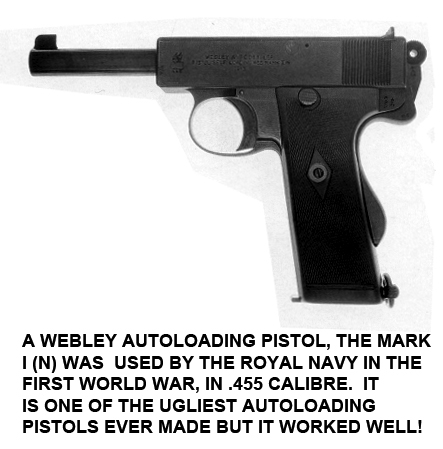 The military-issue Webleys weren’t the only revolvers that used the .455 round and were used in combat. In the late 19th and early 20th Centuries British officers were expected to buy their own handguns, and many of them chose the elegant Webley-Green “Army Model,” a revolver even bigger than the Mark VI. The W-G had the slickest double-action lockwork ever made, and firing one is a real treat. Furthermore it had a reputation for great accuracy; several target versions were made. W-G’s were never issued by the government but were approved for military officers to use. Many were purchased through the Army-Navy Cooperative Services League (a store something like the “post exchange” found on US Army bases today). The CSL stocked home goods, sporting equipment, and other items; it was one of the bigger vendors of the fine W-G revolvers, and those it sold are so marked.
The military-issue Webleys weren’t the only revolvers that used the .455 round and were used in combat. In the late 19th and early 20th Centuries British officers were expected to buy their own handguns, and many of them chose the elegant Webley-Green “Army Model,” a revolver even bigger than the Mark VI. The W-G had the slickest double-action lockwork ever made, and firing one is a real treat. Furthermore it had a reputation for great accuracy; several target versions were made. W-G’s were never issued by the government but were approved for military officers to use. Many were purchased through the Army-Navy Cooperative Services League (a store something like the “post exchange” found on US Army bases today). The CSL stocked home goods, sporting equipment, and other items; it was one of the bigger vendors of the fine W-G revolvers, and those it sold are so marked.

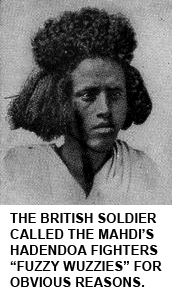 The .455 Webley’s case is slightly longer than the .450 Boxer’s, so the older ammunition could be fired in revolvers chambered for the longer case. The .455 Webley’s standard factory load was rated at 220 FP, using a very heavy
The .455 Webley’s case is slightly longer than the .450 Boxer’s, so the older ammunition could be fired in revolvers chambered for the longer case. The .455 Webley’s standard factory load was rated at 220 FP, using a very heavy 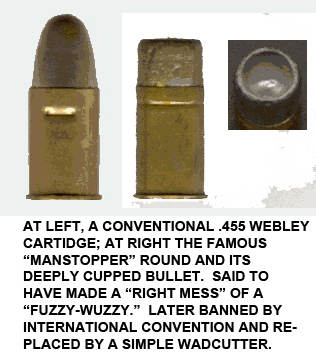 265-grain bullet. Again, the .455 was no speed demon, but over the decades of its use it established a sterling reputation as a combat round. Initially introduced shortly before the Boer War, it was officially issued in the First World War and was “substitute standard” during the Second. It was widely used in many smaller conflicts and is still is in service in some countries. Various ammunition companies still load it.
265-grain bullet. Again, the .455 was no speed demon, but over the decades of its use it established a sterling reputation as a combat round. Initially introduced shortly before the Boer War, it was officially issued in the First World War and was “substitute standard” during the Second. It was widely used in many smaller conflicts and is still is in service in some countries. Various ammunition companies still load it.
One variant of the .455 Webley was the “Manstopper” round. It used a cylindrical bullet with a deep cupped 220-grain hollow point and was said to do fearsome damage on impact. When the Hague Convention banned hollow-point ammunition for military use this was replaced with a solid but still cylindrical bullet—what today we’d call a “wadcutter”—that was technically within the guidelines but no doubt just as effective. Legend has it that these were especially favored for use against the Mahdi’s fanatical “Fuzzy-Wuzzies” in the Sudan campaigns.
Meanwhile, On This Side Of The Pond
For Americans there are two .45 caliber rounds of major importance. These are the .45 Colt (Long) dating from 1873; and the .45 ACP (for “Automatic Colt Pistol”) developed between 1905 and 1907 and adopted as standard Army issue in 1911, in John Browning's best and most famous pistol.
The Ultimately-American Round: .45 Long Colt

The .45 Colt, usually called the “.45 Long Colt” today, was introduced in 1873 and adopted by the US Army in 1875, serving as its official handgun caliber until 1892. It’s most strongly associated with the “cowboy” era of the Old West and has remained in unbroken production for 147 years as of this writing. It’s one of the best and most powerful rounds for self-defense ever conceived. It’s so good that during the Philippine Insurrection, when its replacement (the .38 Long Colt) proved ineffective in combat, the Army recalled old .45-caliber Colt “Peacemaker” single actions from storage for re-issue to combat troops.
The “Long” Colt designation came about because in the 1870’s and 1880’s the Army had two standard issue .45 caliber revolvers. One was a Smith & Wesson firing a very similar round, the .45 Schofield. The S&W gun had a cylinder too short for the Colt round with its longer case. The Schofield round could be fired in Colts, but not the other way around so to avoid problems with ammunition issue cartridges for the Colt guns were labeled “.45 Colt (Long)” to prevent them from being used in the S&W revolvers.
It would be hard to find a better caliber for self-defense than the .45 Long Colt. The standard loading is a 250-grain lead bullet with a muzzle velocity of about 850 FPS and 425 FP but judicious handloading can push it up over 500 FP. That’s more than enough to discourage anyone from bothering you.
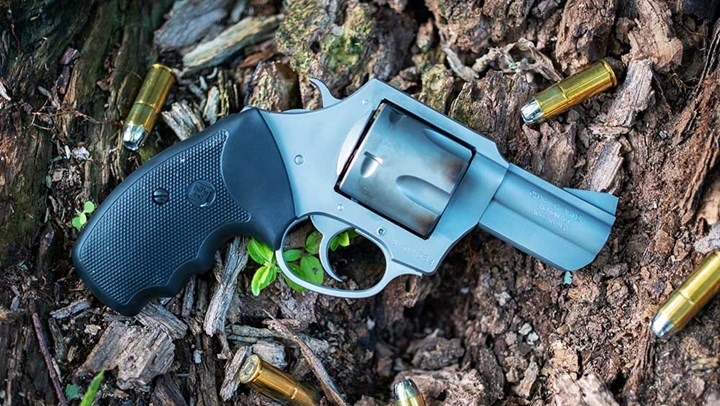
If it has a shortcoming for such uses it’s that the guns firing it are large ones like the Peacemaker. But the innovative Charter Arms Corporation has introduced a variant of their famous “Pitbull” line in .45 Long Colt. (This “Pitbull” is also available in .45 ACP.) The Pitbull is a real bruiser but it will fit in a holster for a “J” frame .38; that means it's light (22 ounces loaded) and fairly easy to conceal. It may only carry five rounds instead of six, and it’s a beast to fire a .45 Long Colt in such a small gun, but by golly, it will do what needs to be done. If you can’t settle a dispute with five rounds from a Pitbull, you have a problem no handgun can solve.
A Plethora of Single Actions
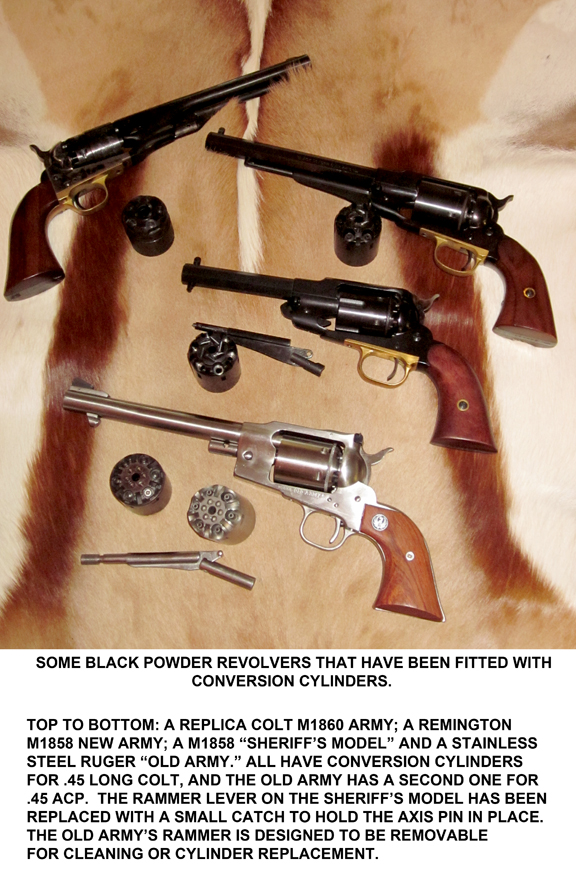 The popularity of “Western” TV shows in the 1960’s created a demand for “cowboy-style guns” that convinced Colt to bring their Single Action Army back into production and many clones were turned out by other makers here and abroad. Somewhat later the “Cowboy Action” shooting fraternity, whose rules require the use of single-action revolvers, boosted sales of the .45 Long Colt substantially and has also been responsible for resurrecting the .45 Schofield round.
The popularity of “Western” TV shows in the 1960’s created a demand for “cowboy-style guns” that convinced Colt to bring their Single Action Army back into production and many clones were turned out by other makers here and abroad. Somewhat later the “Cowboy Action” shooting fraternity, whose rules require the use of single-action revolvers, boosted sales of the .45 Long Colt substantially and has also been responsible for resurrecting the .45 Schofield round.
Big bore percussion revolvers in .44 caliber were the main handguns of the armies on both sides of the American Civil war of 1860-65. But percussion ignition was a transitional technology, soon superseded by the use of fixed ammunition. After the war ended many people who owned quality percussion revolvers wanted the advantages of fixed ammunition without sacrificing the investment they’d made in their handguns. Obligingly Colt, Remington, and some other manufacturers began to produce “conversion cylinders” with which such guns could be fitted to allow use of the new fixed ammunition.
Thus a concatenation of factors led to an interesting situation. A substantial market had been created for single-action revolvers by the Centennial commemorations of the Civil War as well as the TV shows, most especially for single-action revolvers firing the .45 Long Colt. Sooner or later someone must have realized that a “.44 caliber” percussion revolver really isn’t a “.44” at all. Most of them have barrels with a groove diameter pretty close to .450”-.452”; that is, about right for most .45 caliber cartridges. A curious provision of US law—I won’t call it a “loophole,” because it isn’t—omits percussion revolvers using loose powder and bullets from the definition of “firearms” in the never-sufficiently-to-be-cursed Gun Control Act of 1968. Such guns are completely exempt from all its provisions, so that they can be bought and sold with no Federal paperwork. One or two states treat them the same way as “modern” guns but most don’t.
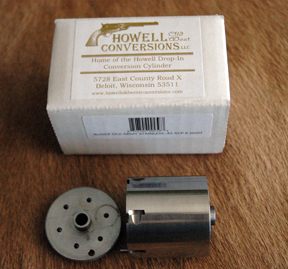 Inevitably this created a cottage industry. A couple of small companies researched those old “conversion” cylinders of the late 19th Century and began making them again, using modern steel and CNC machining methods. New conversion cylinders, “drop-in” fitted to production percussion guns and suitable for use with modern smokeless powders found ready buyers. The conversion cylinders attained considerable popularity not only with Cowboy Action shooters, but also with people who already owned percussion replicas but wanted to avoid the messiness of black powder. Since the replica guns can be bought and sold without restrictions, and the conversion cylinders aren’t “firearms” either, someone who owned, say, a replica Remington Model 1858 in .44 could order a cylinder for it and have a revolver shooting fixed ammunition without hassle. Most of these cylinders are chambered for the .45 Long Colt (which will also handle the .45 Schofield and even the .450 Boxer) but recently there have come on the market conversion cylinders in .45 ACP as well.
Inevitably this created a cottage industry. A couple of small companies researched those old “conversion” cylinders of the late 19th Century and began making them again, using modern steel and CNC machining methods. New conversion cylinders, “drop-in” fitted to production percussion guns and suitable for use with modern smokeless powders found ready buyers. The conversion cylinders attained considerable popularity not only with Cowboy Action shooters, but also with people who already owned percussion replicas but wanted to avoid the messiness of black powder. Since the replica guns can be bought and sold without restrictions, and the conversion cylinders aren’t “firearms” either, someone who owned, say, a replica Remington Model 1858 in .44 could order a cylinder for it and have a revolver shooting fixed ammunition without hassle. Most of these cylinders are chambered for the .45 Long Colt (which will also handle the .45 Schofield and even the .450 Boxer) but recently there have come on the market conversion cylinders in .45 ACP as well.
One revolver that seems almost to have been designed with the conversion cylinders in mind—though it wasn't because it long predated the re-introduction of them —is the (alas) now-discontinued Ruger "Old Army." It isn't old and was never used by any army: it's essentially a Ruger Blackhawk. It's not a replica of any older revolver, but it meets the BATF definition of "antique" and is exempt from the GCA68. It's made from the same steel as the Blackhawk and is immensely strong, far stronger than any true replica. Furthermore, it's labeled as a .45, not a .44. It can be equipped with a spare cylinder in .45 Long Colt and one in .45 ACP.
An Honored Veteran: The .45 ACP

The .45 ACP was the US Army’s official issue pistol caliber from 1911 to 1985, and in fact is still being issued to special units, because there’s nothing else like it for “wet work” in tough spots. The iconic Colt 1911 pistol, designed by the incomparable John M. Browning more than a century ago, is still being made not only by Colt but by many other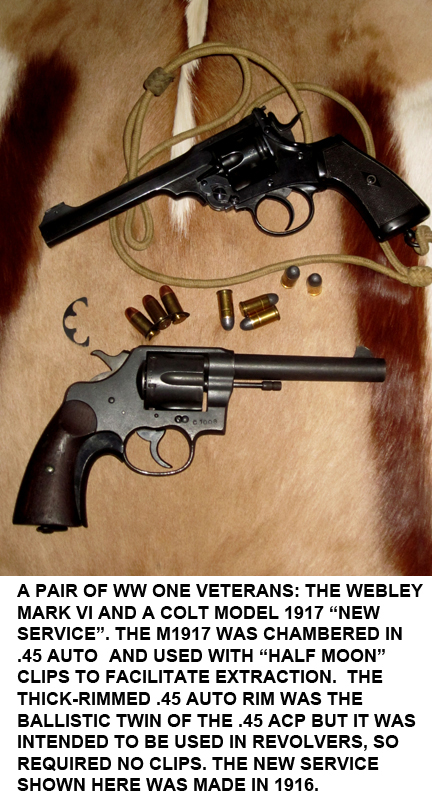 companies. The “1911,” as it’s universally known, and its variants, has been made in untold millions; the Army alone used better than four million in both World Wars, in Korea, in Vietnam, in the Gulf Wars, and many other conflicts. The Navy, Marines, and Air Force issued them; some police agencies did so as well, and unknown numbers—even more millions—ride in holsters of civilians who rely on the .45 ACP to keep the heathen off the front porch and out of the bedroom. Designed in 1902 and introduced to the public in 1905, it’s still as modern as a pistol caliber can be. Its standard loading is a 230-grain bullet at about 850 FPS, for better than 350 FP of energy. Innumerable other factory loads for it exist, many with premium bullets and high-pressure loading.
companies. The “1911,” as it’s universally known, and its variants, has been made in untold millions; the Army alone used better than four million in both World Wars, in Korea, in Vietnam, in the Gulf Wars, and many other conflicts. The Navy, Marines, and Air Force issued them; some police agencies did so as well, and unknown numbers—even more millions—ride in holsters of civilians who rely on the .45 ACP to keep the heathen off the front porch and out of the bedroom. Designed in 1902 and introduced to the public in 1905, it’s still as modern as a pistol caliber can be. Its standard loading is a 230-grain bullet at about 850 FPS, for better than 350 FP of energy. Innumerable other factory loads for it exist, many with premium bullets and high-pressure loading.
An interesting variant of this caliber is the “.45 Auto Rim” round for revolvers. During World War One the Army was short of 1911 pistols so began issuing large-frame Colt and S&W revolvers chambered for .45 ACP. The .45 ACP case is rimless so ejection was a problem unless the cartridges were clipped into metal holders shaped in a semi-circle (“half-moon clips”) that held three rounds. These worked very well, indeed. After the Great War surplus revolvers were released to the civilian market. The Peters Cartridge Company (later absorbed by Remington) developed a case that was dimensionally identical to the .45 ACP except for a thick rim that allowed it to be used in .45 ACP revolvers without the half-moon clips. (Incidentally, because most of the Webley revolvers sold in the USA have had their cylinders shortened to accommodate the .45 ACP in clips—the .455 isn’t easy to find here—the .45 Auto Rim works well in those too.)
Coda
Most of the .45 caliber guns discussed here are too large for concealed carry although the 1911’s are flat enough to be hidden fairly easily. The revolvers—with the exception of the 5-shot Charter Arms—aren't but there are few better choices for an open carry gun for use while camping or hiking in places where one may encounter dangerous animals, especially places where snakes are abundant. Shotshells are available in the .45 Long Colt caliber (and in .45 ACP) which provide an excellent protection against venomous serpents.

Of course, not all dangerous animals are legless or equipped with four legs. The most frequently encountered predators in isolated areas have only two legs. The ballistics of any of these .45's are nothing to be sneezed at in situations involving defense against one of them.
 In fact someone does make a “.46” (the obscure .460 Rowland) but “a Forty-Five” is the standard against which all other handguns are measured, and rightly so. It’s more or less the largest caliber bullet that can be used in a gun of reasonable size by the average person, and its effectiveness has been proven countless times in the field, in combat, on the target range, and even in the backyard popping at old cans and bottles. Such monsters as the S&W’s Model 500 (at left) in .50 caliber, and the Desert Eagle in .50 Action Express, not to mention a few oddities and freak one-offs in calibers like .50 BMG exist, but by no means can any of them be regarded as in the “mainstream,” nor are they of “reasonable” size, something an ordinary person might carry on his person at all, let alone concealed. (The S&W Model 500, on the very large “X” size frame, is so large that some versions are equipped with sling swivels. That isn’t a “handgun” in my book: if you need a sling to carry it, it’s a rifle.) So when it comes to something you can carry comfortably and (especially if it’s to be concealed) a “Forty-five” is it.
In fact someone does make a “.46” (the obscure .460 Rowland) but “a Forty-Five” is the standard against which all other handguns are measured, and rightly so. It’s more or less the largest caliber bullet that can be used in a gun of reasonable size by the average person, and its effectiveness has been proven countless times in the field, in combat, on the target range, and even in the backyard popping at old cans and bottles. Such monsters as the S&W’s Model 500 (at left) in .50 caliber, and the Desert Eagle in .50 Action Express, not to mention a few oddities and freak one-offs in calibers like .50 BMG exist, but by no means can any of them be regarded as in the “mainstream,” nor are they of “reasonable” size, something an ordinary person might carry on his person at all, let alone concealed. (The S&W Model 500, on the very large “X” size frame, is so large that some versions are equipped with sling swivels. That isn’t a “handgun” in my book: if you need a sling to carry it, it’s a rifle.) So when it comes to something you can carry comfortably and (especially if it’s to be concealed) a “Forty-five” is it.  The Ancestral .450 Boxer
The Ancestral .450 Boxer  I’ll begin with the .450 Boxer, which today is so obscure that most shooters have never heard of it. It's also known by some other names, and is sometimes called the ".450 Adams," but the "Boxer" designation was given by the British Army and it stuck. It’s still loaded by one company to serve those who own old guns chambered for it. More importantly it’s more or less the lineal ancestor of the much better-known .455 Webley. So it’s significant in more ways than one.
I’ll begin with the .450 Boxer, which today is so obscure that most shooters have never heard of it. It's also known by some other names, and is sometimes called the ".450 Adams," but the "Boxer" designation was given by the British Army and it stuck. It’s still loaded by one company to serve those who own old guns chambered for it. More importantly it’s more or less the lineal ancestor of the much better-known .455 Webley. So it’s significant in more ways than one.

 Undoubtedly the best-known guns that fired the .455 Webley are the big military top-breaks used by the British Army beginning in 1887 when the Mark I was adopted. Webley .455’s were used well into the 1950’s, when the UK began its post-WW 2 rearmament with the Browning Hi-Power. The Mark VI is the most iconic of the series of military Webleys, but earlier Marks had been used in the Boer War, in fighting the forces of the Mahdi, and many other conflicts. Early Marks had a curved “bird’s head” grip, but the Mark VI had a large square one. All were formidable fighting weapons, especially the Mark VI. They were issued to officers in World War One and many Mark VI’s went “over the top” against the Kaiser’s forces. Not a few were fired in anger against the armies of the Axis a couple of decades later. The Mark V was discontinued in 1915, and the Mark VI introduced that same year; the two guns shown here were both manufactured in 1915. The Holy Grail of Webley collectors is the Webley-Fosbery “Automatic Revolver,” which is so odd and so rare that few people, even advanced students of firearms, have ever seen one. It deserves its own essay, so I’ll just say here that it fired the same .455 Webley revolver round as the Mark VI, and leave it at that.
Undoubtedly the best-known guns that fired the .455 Webley are the big military top-breaks used by the British Army beginning in 1887 when the Mark I was adopted. Webley .455’s were used well into the 1950’s, when the UK began its post-WW 2 rearmament with the Browning Hi-Power. The Mark VI is the most iconic of the series of military Webleys, but earlier Marks had been used in the Boer War, in fighting the forces of the Mahdi, and many other conflicts. Early Marks had a curved “bird’s head” grip, but the Mark VI had a large square one. All were formidable fighting weapons, especially the Mark VI. They were issued to officers in World War One and many Mark VI’s went “over the top” against the Kaiser’s forces. Not a few were fired in anger against the armies of the Axis a couple of decades later. The Mark V was discontinued in 1915, and the Mark VI introduced that same year; the two guns shown here were both manufactured in 1915. The Holy Grail of Webley collectors is the Webley-Fosbery “Automatic Revolver,” which is so odd and so rare that few people, even advanced students of firearms, have ever seen one. It deserves its own essay, so I’ll just say here that it fired the same .455 Webley revolver round as the Mark VI, and leave it at that.  The military-issue Webleys weren’t the only revolvers that used the .455 round and were used in combat. In the late 19th and early 20th Centuries British officers were expected to buy their own handguns, and many of them chose the elegant
The military-issue Webleys weren’t the only revolvers that used the .455 round and were used in combat. In the late 19th and early 20th Centuries British officers were expected to buy their own handguns, and many of them chose the elegant 
 The .455 Webley’s case is slightly longer than the .450 Boxer’s, so the older ammunition could be fired in revolvers chambered for the longer case. The .455 Webley’s standard factory load was rated at 220 FP, using a very heavy
The .455 Webley’s case is slightly longer than the .450 Boxer’s, so the older ammunition could be fired in revolvers chambered for the longer case. The .455 Webley’s standard factory load was rated at 220 FP, using a very heavy  265-grain bullet. Again, the .455 was no speed demon, but over the decades of its use it established a sterling reputation as a combat round. Initially introduced shortly before the Boer War, it was officially issued in the First World War and was “substitute standard” during the Second. It was widely used in many smaller conflicts and is still is in service in some countries. Various ammunition companies still load it.
265-grain bullet. Again, the .455 was no speed demon, but over the decades of its use it established a sterling reputation as a combat round. Initially introduced shortly before the Boer War, it was officially issued in the First World War and was “substitute standard” during the Second. It was widely used in many smaller conflicts and is still is in service in some countries. Various ammunition companies still load it. 

 The popularity of “Western” TV shows in the 1960’s created a demand for “cowboy-style guns” that convinced Colt to bring their Single Action Army back into production and many clones were turned out by other makers here and abroad. Somewhat later the “Cowboy Action” shooting fraternity, whose rules require the use of single-action revolvers, boosted sales of the .45 Long Colt substantially and has also been responsible for resurrecting the .45 Schofield round.
The popularity of “Western” TV shows in the 1960’s created a demand for “cowboy-style guns” that convinced Colt to bring their Single Action Army back into production and many clones were turned out by other makers here and abroad. Somewhat later the “Cowboy Action” shooting fraternity, whose rules require the use of single-action revolvers, boosted sales of the .45 Long Colt substantially and has also been responsible for resurrecting the .45 Schofield round.  Inevitably this created a cottage industry. A couple of small companies researched those old “conversion” cylinders of the late 19th Century and began making them again, using modern steel and CNC machining methods. New conversion cylinders, “drop-in” fitted to production percussion guns and suitable for use with modern smokeless powders found ready buyers. The conversion cylinders attained considerable popularity not only with Cowboy Action shooters, but also with people who already owned percussion replicas but wanted to avoid the messiness of black powder. Since the replica guns can be bought and sold without restrictions, and the conversion cylinders aren’t “firearms” either, someone who owned, say, a replica Remington Model 1858 in .44 could order a cylinder for it and have a revolver shooting fixed ammunition without hassle. Most of these cylinders are chambered for the .45 Long Colt (which will also handle the .45 Schofield and even the .450 Boxer) but recently there have come on the market conversion cylinders in .45 ACP as well.
Inevitably this created a cottage industry. A couple of small companies researched those old “conversion” cylinders of the late 19th Century and began making them again, using modern steel and CNC machining methods. New conversion cylinders, “drop-in” fitted to production percussion guns and suitable for use with modern smokeless powders found ready buyers. The conversion cylinders attained considerable popularity not only with Cowboy Action shooters, but also with people who already owned percussion replicas but wanted to avoid the messiness of black powder. Since the replica guns can be bought and sold without restrictions, and the conversion cylinders aren’t “firearms” either, someone who owned, say, a replica Remington Model 1858 in .44 could order a cylinder for it and have a revolver shooting fixed ammunition without hassle. Most of these cylinders are chambered for the .45 Long Colt (which will also handle the .45 Schofield and even the .450 Boxer) but recently there have come on the market conversion cylinders in .45 ACP as well. 
 companies. The “1911,” as it’s universally known, and its variants, has been made in untold millions; the Army alone used better than four million in both World Wars, in Korea, in Vietnam, in the Gulf Wars, and many other conflicts. The Navy, Marines, and Air Force issued them; some police agencies did so as well, and unknown numbers—even more millions—ride in holsters of civilians who rely on the .45 ACP to keep the heathen off the front porch and out of the bedroom. Designed in 1902 and introduced to the public in 1905, it’s still as modern as a pistol caliber can be. Its standard loading is a 230-grain bullet at about 850 FPS, for better than 350 FP of energy. Innumerable other factory loads for it exist, many with premium bullets and high-pressure loading.
companies. The “1911,” as it’s universally known, and its variants, has been made in untold millions; the Army alone used better than four million in both World Wars, in Korea, in Vietnam, in the Gulf Wars, and many other conflicts. The Navy, Marines, and Air Force issued them; some police agencies did so as well, and unknown numbers—even more millions—ride in holsters of civilians who rely on the .45 ACP to keep the heathen off the front porch and out of the bedroom. Designed in 1902 and introduced to the public in 1905, it’s still as modern as a pistol caliber can be. Its standard loading is a 230-grain bullet at about 850 FPS, for better than 350 FP of energy. Innumerable other factory loads for it exist, many with premium bullets and high-pressure loading. 